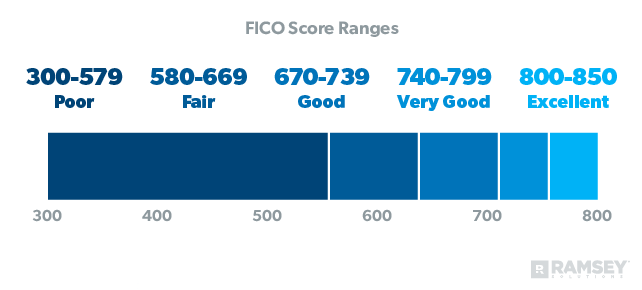How to Read Your Credit Report

By now, you know exactly how we feel about credit scores (hint: they’re bogus). But one thing you still need to pay attention to is your credit report. Even if you’re debt-free and don’t care what big banks and lenders think of you, you can’t just ignore your credit report. You still need to check it for errors or signs of fraud at least once a year.
But sifting through these things can be pretty confusing, especially if you don’t know how to read your credit report or what kind of red flags to look for. We know it can be a lot to take in. But don’t worry! We’ve done the heavy lifting so you don’t have to. Ready, set, let’s walk through everything you need to know about how to read your credit report.
What Is a Credit Report?
A credit report is kind of like a report card for your credit history. It can be used by potential lenders to determine your “risk,” which is basically just how likely you are to pay your monthly payments on time. A credit report all about you can tell them:
-
The date you opened any credit accounts or took out any loans
-
The current balance on each account
-
Your payment history
-
The credit limits and total loan amounts
-
Any bankruptcies or tax liens
-
Your identifying information (name, address, Social Security number)
A credit bureau or credit-reporting company like Equifax, Experian or TransUnion will provide your information to whatever company may be considering giving a loan or credit account. These bureaus all operate independently, so their reports on you may contain slightly different information depending on the credit-reporting company they used.
How to Get a Credit Report
You’re allowed one free copy of your credit report every year from each of the major credit-reporting agencies we just talked about. But the reports aren’t automatically mailed to you—you have to ask for them! And since each agency keeps different details on file, it’s worth checking with all three. If you play your cards right, you can even stagger them so you’re getting a free report nearly every quarter.
Take control of your money with a FREE Ramsey+ trial.
Now that you know how to get your credit report, we’ll walk you through the four major areas you need to check for any red flags. These could help you spot potential identity theft situations, so listen up!
How to Read Your Credit Report
Identifying Information
This section has any personal information that could be used to identify you, including:
-
Name
-
Address
-
Social Security number
-
Date of birth
-
Phone number
Red Flags: Everything in this section needs to refer to you and not someone else who happens to share your name, Mr. Jones. And while you’re at it, go ahead and double-check the Social Security number just in case, too.
Make sure all the addresses listed are places you’ve actually lived. If you’ve never been to Waxahachie, Texas, but the report says you lived there for seven years, you might want to follow up on that. We’ll share later what steps to follow if you do find errors in your report.
Credit History
The bulk of the report is in this section. Your credit history includes:
-
Open and paid credit accounts, like credit cards, mortgages and loans
-
Accounts shared with someone else
-
Total loan amounts
-
Remaining loan balances
-
Late payments
-
Accounts that have been sent to collections
Red Flags: Read and reread this section to make sure everything listed is right. Got it? Okay. Now check again. Seriously. Look for accounts that were opened that sound unfamiliar, and check for payments being noted as late when they actually weren’t.
If you’ve closed a credit card account, confirm it’s showing up as closed on your credit report. Also, make absolutely sure no lines of credit have been opened in your name without your consent—that’s a huge red flag and might mean you’re at risk of identity theft.
Public Records
You want this part to be blank. The financial activity listed here—like bankruptcy, tax liens and judgments—is taken from public records, and some things can stay on your credit report for upwards of 7–10 years.
Red Flags: It’s pretty rare to find an error in this part of the report, but it’s worth scanning anyway. Mistakes in this section should be cleared up ASAP.
Inquiries
Here you’ll see detailed listings of every business that has requested your credit report. There are two types of credit inquiries: soft and hard. Soft inquiries are just from companies wanting to send you promotional materials or current creditors checking your account. Hard inquiries are made when you actually apply for a credit card, loan or mortgage.
Red Flags: Hard inquiries cause your credit score to drop a few points, so be sure you’ve truly given your permission for a hard inquiry to your credit. These should disappear from your report after about two years.
What does an “open account” mean on my credit report?
An open account is any line of credit you’ve opened and never officially closed. You know, like that paid-off department store credit card you forgot to call about and cancel. Even if you haven’t used a credit card for a few years, it will still show up as an open account on your credit report until you contact the company to close the account. So, stop having cold feet and just go ahead and close it for good.
What does a “U” stand for on a credit report?
University of Credit Reporting? Nope. The “U” means “unclassified,” or that the account hadn’t been updated at the time the report was pulled. It’s one of many status codes that can appear next to an account on your credit report. Codes like this usually indicate a problem with the account, like it being past due or sent to collections.
You might also see a “U” if the account is new and you haven’t made any payments on it yet. It doesn’t have a negative impact on your credit score and isn’t anything to really worry about.
Who can see my credit report?
Most people can’t legally use your personal information to access your credit report. However, there are several types of organizations that are allowed to pull your credit: banks, creditors, lenders, insurance companies, potential landlords, collections agencies, potential employers and the government.
The laws about who can access your credit score are different from state to state. If you’re worried at all, do some research and find out what the law is where you live.
Where can I find my credit score?
If you got a free credit report, don’t be surprised when it doesn’t include your credit score. To see that, you’ll have to use a free web service or pay for it through MyFico.com or a credit bureau.

But keep in mind, when it all comes down to it, a credit score is really just an “I love debt” score. That’s right, a “good score” simply shows how well you’ve played the debt game. It doesn’t reflect your actual net worth or the amount of money you have in the bank. In other words, it’s nothing to be proud of. The only way to keep your stellar credit score is to live in debt and stay there. No thanks!
It is possible to live life without a credit score, which is exactly what Dave recommends. But that doesn’t mean you should trash your credit to lower it! Just start paying off your debt, close your credit accounts once they’re paid off, and don’t take on any new debt. If you’re following the Baby Steps, you should reach that indeterminable score within a few months to a few years. Remember: No credit is not the same as having a low credit score.
Can someone run a credit report without me knowing?
It depends. Like we said earlier, there are soft inquiries and hard inquiries. Soft inquiries happen all the time without you even knowing—a company might check your credit score if they’re planning on mailing you a promotional offer. These inquiries don’t affect your credit score at all.
But hard inquiries require your actual consent before they can happen. These impact your credit score and can’t legally be done without you knowing, so breathe easy. If you notice a hard inquiry you didn’t authorize, you’ll need to dispute it with the credit agency.
How to Dispute Inaccuracies
Any mistakes on your credit report need to be taken up with the agency that shows the error. Write a letter that lists each incorrect item you found and why you’re disputing it.
Let’s say you closed a credit card, but it still shows up as an open account on your credit report. Here’s what you need to do: Gather up documents and any evidence you might have to prove it’s a mistake. Then, send all of this by certified mail—and don’t forget a return receipt! The agency has only 30 days to respond, so you should see some movement pretty quickly.
Avoid Identity Theft
Your credit report might seem complicated at first, but now that you know what to look for, hopefully it’s not so daunting. It’s never a bad idea to be proactive and make sure everything is correct.


